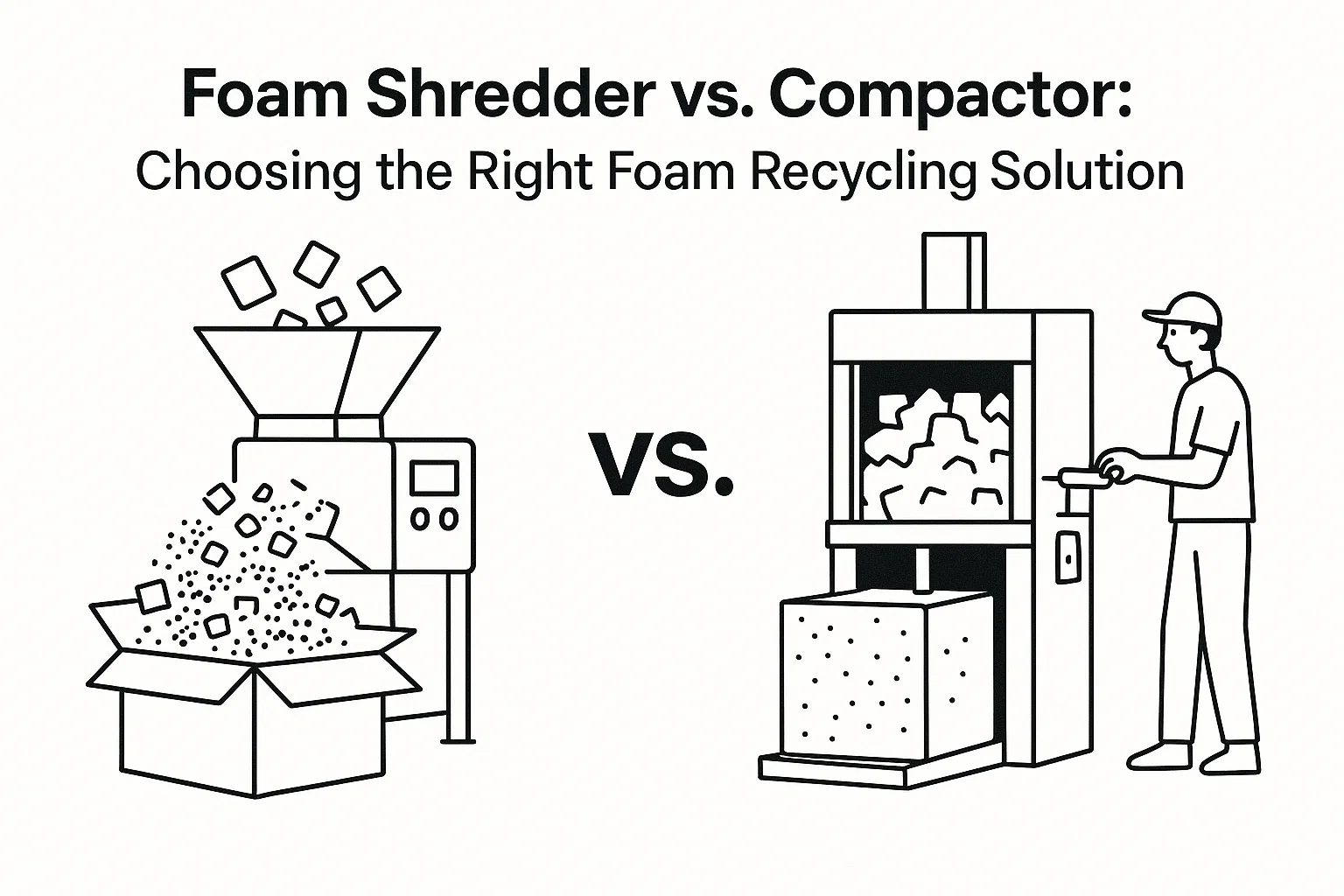Déchiqueteuse de mousse vs. Compacteur : Choisir la bonne solution de recyclage de mousse
Efficace recyclage de la mousse est une tâche essentielle pour les entreprises des secteurs de l'emballage, de la fabrication et de la logistique. La mousse étant essentiellement composée d'air, elle est encombrante et légère, ce qui pose d'importants problèmes de stockage et de transport. Deux types de machines permettent de résoudre ce problème : les broyeurs et les compacteurs de mousse. Bien qu'ils jouent tous deux un rôle dans la gestion des déchets, ils remplissent des fonctions différentes et sont adaptés à des objectifs opérationnels distincts. Il est essentiel de comprendre leurs différences pour optimiser votre flux de recyclage et réduire les coûts.
La principale tâche d'un broyeur de mousse est de réduire la taille des pièces, en décomposant les gros morceaux de mousse en fragments plus petits et plus faciles à gérer. Un compacteur de mousse, quant à lui, se concentre sur la réduction du volume, comprimant la mousse en blocs denses et empilables. Pour de nombreuses entreprises, le choix n'est pas nécessairement l'un ou l'autre, mais plutôt de comprendre comment chaque machine s'intègre dans une stratégie de recyclage complète.
Qu'est-ce qu'un broyeur de mousse ?
Un broyeur de mousse est une machine conçue pour la première étape de nombreux processus de recyclage : décomposer les déchets de mousse volumineux et difficiles à manipuler. À l'aide de puissantes lames rotatives, il coupe et déchire des matériaux tels que le polystyrène expansé (EPS), le polyuréthane (PU) et le polyéthylène expansé (EPE) en petits flocons ou en billes. Ce processus ne réduit pas le volume global de la mousse, mais la transforme en un format cohérent et gérable pour un traitement en aval ou une réutilisation directe.
Fonctionnement des broyeurs de mousse et leurs principales utilisations
Le mécanisme de base d'un broyeur de mousse consiste à introduire de la mousse volumineuse dans une chambre où des lames robustes la brisent. Le matériau broyé qui en résulte est beaucoup plus facile à manipuler, à transporter et à introduire dans d'autres équipements.
Les principales applications de la mousse déchiquetée sont les suivantes
- Préparation au compactage : Le déchiquetage est souvent une étape préliminaire nécessaire avant le compactage, garantissant que le compacteur reçoit une matière première uniforme pour un traitement efficace.
- Matériau de remplissage : La mousse déchiquetée peut être réutilisée comme matériau de remplissage léger pour des produits tels que des poufs, des coussins et des jouets.
- Matériaux de construction : Dans le secteur de la construction, la mousse déchiquetée est parfois mélangée à du béton pour créer des blocs isolants légers.
- Conditionnement: Les petits fragments de mousse peuvent servir d'emballage de protection en vrac pour l'expédition d'articles fragiles.
Avantages d'un broyeur de mousse
- Versatilité: Peut traiter différents types de mousses, y compris des mousses rigides et souples comme l'EPS, l'XPS et le PU.
- Création de matériaux réutilisables : Le produit obtenu peut être directement réutilisé comme matériau de remplissage ou d'emballage sans autre traitement.
- Améliore le flux de travail : Prépare la mousse à un compactage ou à une granulation plus efficace, ce qui permet d'améliorer le processus de recyclage dans son ensemble.
Inconvénients d'un broyeur de mousse
- Pas de réduction de volume : Le déchiquetage ne réduit que la taille des pièces, et non l'espace total occupé par la mousse.
- Il s'agit souvent d'une étape intermédiaire : Pour les entreprises axées sur le transport et la revente, un broyeur seul est généralement insuffisant.
- Génération de poussière : Le processus de déchiquetage peut générer de la poussière, ce qui peut nécessiter une gestion supplémentaire.
Qu'est-ce qu'un compacteur de mousse ?
Un compacteur de mousse, également connu sous le nom de densificateur, est spécialement conçu pour s'attaquer au principal défi posé par les déchets de mousse : leur immense volume. Ces machines utilisent la pression pour extraire l'air de la mousse, réduisant ainsi son volume dans une proportion pouvant aller jusqu'à 50:1. Le résultat est un bloc ou une bille dense et solide, facile à empiler, à stocker et à transporter, qui transforme les déchets de mousse en un produit de valeur.
Types de compacteurs de mousse et leur fonctionnement
Les compacteurs de mousse se répartissent généralement en trois catégories en fonction de leur mécanisme :
- Compacteurs à froid (à vis) : Il s'agit du type le plus courant. Une grande vis sans fin écrase la mousse et la pousse à travers une chambre, en appliquant une pression intense pour expulser l'air. Ce processus mécanique génère une certaine chaleur due à la friction, mais ne fait pas fondre activement le matériau. Ils sont efficaces sur le plan énergétique et conviennent parfaitement aux matériaux tels que l'EPS et l'XPS.
- Densificateurs thermiques : Ces machines utilisent la chaleur pour faire fondre la mousse lorsqu'elle est comprimée. La mousse fondue est ensuite extrudée et refroidie en un lingot très dense et solide. Cette méthode permet d'obtenir les taux de compression les plus élevés, souvent jusqu'à 90:1, ce qui la rend idéale pour préparer la mousse au transport sur de longues distances.
- Compacteurs hydrauliques : Une puissante presse hydraulique écrase la mousse entre deux plaques, la compactant en un bloc solide. Ces systèmes sont particulièrement efficaces pour traiter des densités mixtes de mousse, ce qui peut être courant dans les installations de recyclage municipales.
Avantages d'un compacteur de mousse
- Réduction significative du volume : Réduit considérablement les coûts de stockage et de transport dans des proportions allant jusqu'à 50:1, voire 90:1.
- Créer un produit vendable : Les blocs de mousse compactée sont une matière première recherchée par les fabricants de nouveaux produits en plastique.
- Amélioration de la logistique : Les blocs denses et empilables sont faciles à manipuler et à charger sur des palettes pour l'expédition.
- Avantages environnementaux : Permet de détourner des quantités massives de mousse non biodégradable des décharges.
Inconvénients d'un compacteur de mousse
- Investissement initial plus élevé : Ces machines sont généralement plus coûteuses que les broyeurs autonomes.
- Consommation d'énergie : Les densificateurs thermiques, en particulier, nécessitent plus d'énergie pour fonctionner en raison de leurs éléments chauffants.
- Spécificité du Matériau : Certains compacteurs donnent de meilleurs résultats avec un type et une densité de mousse constants.
Optimisez votre recyclage de mousse avec Energycle
Notre gamme de machines de recyclage du PSE à haute performance est conçue pour traiter efficacement vos déchets de mousse. Transformez dès aujourd'hui vos déchets de mousse encombrants en une ressource gérable et précieuse.
Voir les détails de la machineAvez-vous besoin des deux ? Le système intégré de recyclage de la mousse
Pour de nombreuses opérations à grande échelle, l'approche la plus efficace pour recyclage de la mousse n'est pas de choisir entre un broyeur et un compacteur, mais de les intégrer dans un système unique et rationalisé. Dans cette configuration, le broyeur de mousse joue le rôle de première étape, en réduisant les déchets de mousse incohérents et volumineux en une taille uniforme. Ce matériau déchiqueté est ensuite introduit dans le compacteur, qui peut fonctionner de manière plus cohérente et plus efficace avec la matière première préparée.
Ce processus en deux étapes maximise à la fois la réduction de la taille et du volume, garantissant la plus haute densité possible dans les blocs finaux. Il s'agit de la solution optimale pour les entreprises qui traitent de gros volumes de déchets de mousse divers et qui souhaitent produire un produit recyclé commercialisable de haute qualité.
Guide de décision : Choisir la bonne machine pour votre entreprise
Le choix de l'équipement adéquat dépend entièrement de vos besoins spécifiques. Tenez compte de ces facteurs clés pour prendre une décision éclairée :
1. Quel est votre objectif principal ?
- Réutilisation de la mousse en interne : Si vous envisagez de réutiliser la mousse comme matériau de remplissage pour vos propres produits (meubles, emballages, etc.), il convient d'utiliser un broyeur de mousse est probablement tout ce dont vous avez besoin.
- Réduction des coûts d'élimination et de transport : Si votre objectif principal est de réduire l'espace de stockage et les frais de transport, une compacteur de mousse est le choix qui s'impose.
- Vente de Matériau Recyclé : Pour produire des blocs denses et à valeur élevée à vendre aux recycleurs, un compacteur compacteur de mousse (et potentiellement un broyeur pour le pré-traitement) est essentiel.
2. Quel Type et Volume de Mousse Gérez-vous ?
- Type de Mousse : Identifiez la mousse que vous traitez le plus. S'agit-il principalement de EPS (Polystyrène Expansible), EPE (Polyéthylène Expansible) ou PU (Polyuréthane) ? Bien que de nombreuses machines soient polyvalentes, certaines sont optimisées pour des matériaux spécifiques. Par exemple, les densificateurs hydrauliques sont excellents pour les flux à densité mixte.
- Volume : Une petite entreprise avec des déchets de mousse occasionnels pourrait s'en tenir à un compacteur plus petit. Une grande usine de fabrication ou une installation de recyclage nécessitera un système à haute capacité, probablement intégrant à la fois un broyeur et un compacteur, pour suivre le flux de déchets.
3. Quel est Votre Budget et Espace Disponible ?
- Investissement : Un broyeur autonome représente un point d'entrée moins coûteux dans le recyclage de la mousse. Un compacteur, en particulier un densificateur thermique, nécessite un investissement capital plus important mais offre une voie plus claire vers le retour sur investissement grâce à des économies de coûts et la génération de revenus.
- Surface : Assurez-vous d'avoir suffisamment d'espace physique pour la machine et pour stocker à la fois la mousse non traitée et traitée. Les compacteurs réduisent considérablement l'espace nécessaire pour le matériel traité.
En fin de compte, à la fois les broyeurs de mousse et les compacteurs sont des outils essentiels dans l'effort de gestion responsable des déchets plastiques. En évaluant vos objectifs opérationnels, les types de matériaux et vos besoins logistiques, vous pouvez choisir l'équipement qui non seulement résout votre problème de déchets de mousse mais contribue également positivement à votre trésorerie et à vos objectifs environnementaux. Pour en savoir plus sur la manière dont nos solutions peuvent s'intégrer à vos opérations, explorez la Machine Energycle page d'accueil ou consultez l'un de nos spécialistes.
Pour en savoir davantage sur l'importance du recyclage des plastiques, l'Agence américaine de protection de l'environnement (EPA) fournit des ressources précieuses sur la gestion durable des matériaux.



